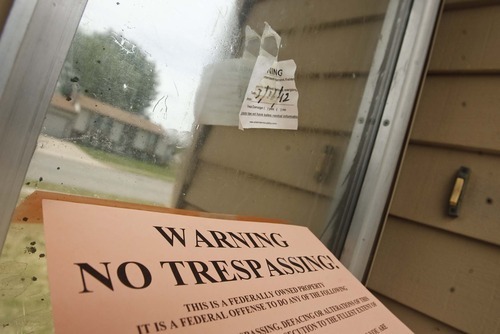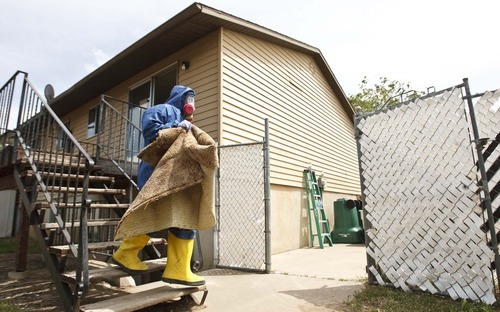This is an archived article that was published on sltrib.com in 2012, and information in the article may be outdated. It is provided only for personal research purposes and may not be reprinted.
An oddball sign that the housing market is picking up? The number of homes contaminated with meth is up, too.
The Salt Lake Valley Health Department has closed 129 properties in Salt Lake County this year due to methamphetamine contamination, already near last year's total of 136.
But instead of finding homes contaminated by labs, public health officials and decontamination experts say they are seeing more properties affected by meth use.
And they urge all buyers to test for the drug, since telltale signs don't often exist anymore. Walls stained with iodine or red phosphorus from large-scale meth production has given way to "shake n' bake" operations that contain the ingredients in a 2-liter soda bottle, but can still cause contamination.
The drug — produced from over-the-counter medications and common household chemicals — can be absorbed through the skin from contaminated surfaces.
"If I were buying a house I would [have it inspected]," said Kerry Cramer, supervisor in the health department's sanitation bureau.
The Utah Department of Health also recommends testing for meth before all property transactions.
While buyers of foreclosed or bank-owned homes may be more apt to send samples to a lab, Cramer said meth use defies stereotypes. "We have had brand new houses where the contractor was actually smoking meth in there."
Effects like paranoia, insomnia, anxiety and aggression are seen among meth users. But the evidence on what level of contamination causes health problems is limited. The Utah Department of Health acknowledges that low-level exposure to nonusers is not well studied.
"If it's smoked in there a couple of times, it's still going to show up positive on our samples but it may not be a health issue," said Fred Larsen, a Riverton-based home inspector and president of the Utah chapter of the American Society of Home Inspectors. In his opinion, "There's a lot of houses that are being expensively decontaminated that would not be a health risk."
Utah health officials increased the allowable limit by 10-fold in 2009 to less than or equal to 1 microgram per 100 square centimeters, based on research by the California Office of Environmental Health Hazards Assessment.
California set its limit at 1.5 micrograms based on a 1961 study on the use of meth to help overweight pregnant women lose weight.
"We cut it back another half to err on the side of caution," said Cramer, who was on the state committee that recommended the change.
He couldn't say what the health effects would be for someone to live in a house contaminated at near the legal limit.
"This is just the cautious standard that has been adopted by the state. ... We don't want to turn our heads and say there's not a problem."
Health departments get involved with meth-contaminated properties when police bust a lab. The health department closes it to entry until the property owner tests it and decontaminates if necessary. It will also close a home if a certified decontamination specialist finds high levels after testing.
The Salt Lake Valley Health Department shut down 80 homes in 2009, 97 in 2010 and 136 last year. Astute homebuyers are asking for the tests and home inspectors are more apt to offer them.
The health department — which must review decontamination work plans and final reports showing the meth levels are below the legal limit — said contamination in the closed homes have ranged from just above 1 microgram to 100 micrograms and higher.
Since many of the closed homes are likely where meth was used and not produced, that tells Cramer that "people are using meth more in the house before they're busted or before the house goes up for sale."
About 10 percent of Larsen's clients ask for a $110 test. A quarter of the homes tested come back positive, he said. Buyers of bank-owned homes are more likely to seek testing.
"We're asked more often to test something like that than a clean, higher end house," he said.
The cities with the highest number of closures last year were Salt Lake City (37), West Valley City (30), Taylorsville (13) and Magna (12).
There is some debate one what is the best method for testing for meth. While home inspectors may sample one area of the house, certified decontamination specialists do more extensive testing, which costs more. Joe Mazzuca, operations manager for Meth Lab Cleanup Company, based in Idaho with an office in Salt Lake City, said the testing cost ranges from $300 to $700. Clean-up averages $5,000.
Mazzuca complains that tests by home inspectors turn up positive but when he retests the levels are below the limit.
Nevertheless, "There are a lot of properties that are coming back positive, usually at very low levels."
The health department does not accept test results from home inspectors as a basis for closing properties. Instead, the county health department will post a green advisory warning of a "possible chemical hazard."
Meth addiction in Utah
After alcohol and opiates (illegal and prescription drugs), methamphetamine was the third-most common reason for admission to Utah's public substance abuse treatment programs in 2011. Twenty-five percent of women and 14 percent of men in the system sought treatment for meth.
Source: Utah Division of Substance Abuse and Mental Health 2011 report.









